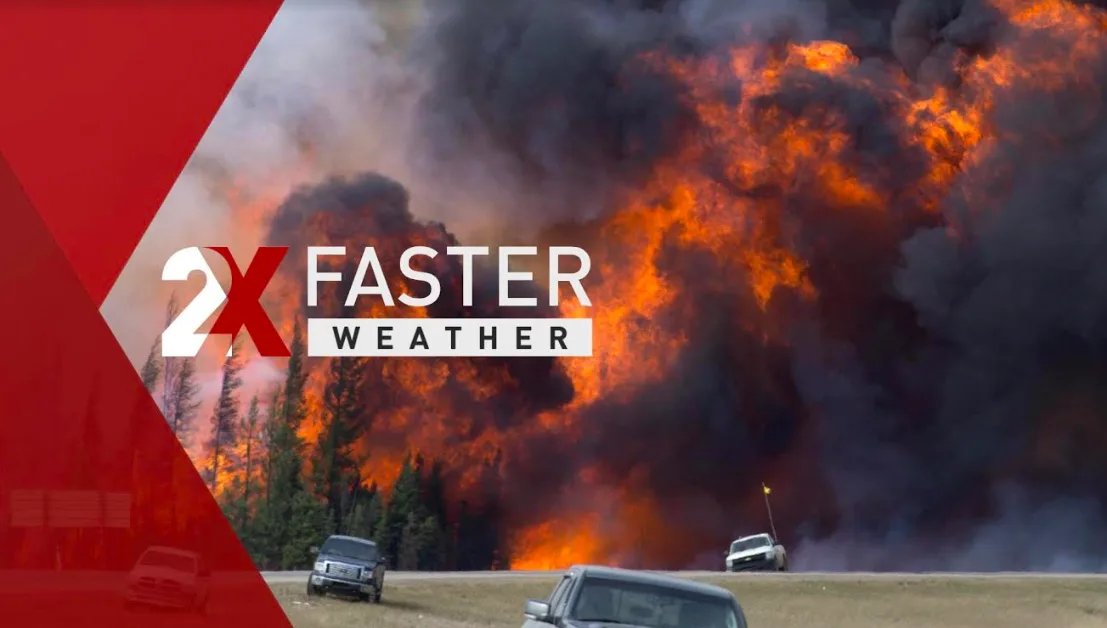
2X Faster: Severe weather events are a new Canadian normal
The Weather Network is rolling out a three-part series that will analyze how this report will impact each region of the country. This is the first installment of our 2X Faster series and will address how Canadian weather is impacted by global climate change.
The new climate change report released by the Canadian government confirms that significant environmental changes are leaving visible impacts - heavy rainstorms are triggering catastrophic flooding, summer heatwaves are becoming longer and hotter, and extreme weather events are occurring more frequently.
The findings of the new report come from a comprehensive review of scientific studies that analyze the environmental crisis we are currently facing, and how climate change will progress in the future depending on global carbon dioxide emissions. Carbon dioxide emissions are projected to rise throughout this century, and scientists confirm that the increase in damaging extreme weather events is becoming the new normal for Canadian weather.
Temperature and precipitation are amongst the most extensively studied indicators of climate, and analyzing their trends over time demonstrates that their patterns have been changed by human-released greenhouse gases. This article will address how temperature and precipitation will change throughout Canada as a result of climate change, based on the findings of Canada's Changing Climate Report (CCCR).
HOW ARE EXTREME WEATHER EVENTS AND CLIMATE CHANGE RELATED?
Greenhouse gases that have been released by humans impact Canadian weather in a number of ways. Pollutants, such as methane and carbon dioxide, create a warming effect inside the Earth's atmosphere, and a warmer atmosphere holds more moisture.
A 1°C warming results in an increase of about 7 per cent more moisture in the atmosphere, which creates a larger moisture supply for storms that produce heavier rain and snowfall. The report states that if we continue on a business-as-usual carbon emissions scenario, the atmosphere could warm by more than 6°C by 2100 and could potentially hold 42 per cent more moisture than the present day. The increasing supply of moisture will directly fuel storms that could release larger amounts of rain and snow, which heightens the probability of increasingly damaging and dangerous storms.
The warming atmosphere is also responsible for the rising temperatures and increasingly frequent heatwaves. Temperature is a key indicator of climate change because it is directly correlated with the concentration of carbon dioxide in the atmosphere.
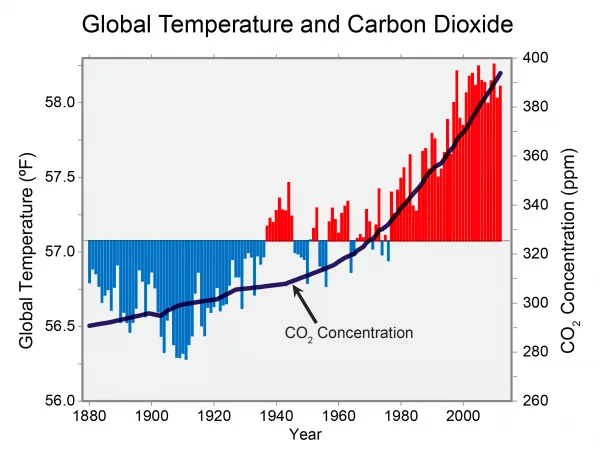
Credit: U.S. Global Change Research Program
In the business-as-usual scenario (RCP 8.5) for carbon dioxide emissions, the annual highest daily temperature that would happen once every fifty years on average will become a once every five years event by 2050, which is ten times more frequent. Not only have annual temperatures increased across Canada, but each seasonal average temperature has increased, with the greatest warming occurring in the winter season.
The changes in Canadian weather due to climate change are apparent, and the report has found direct climate change links to some of the most damaging weather events in Canadian history, such as the 2016 Fort McMurray wildfire. Read below to see what the CCCR report has projected for your region of Canada.
PROJECTED CHANGES IN TEMPERATURE AND PRECIPITATION FOR EACH REGION IN CANADA
Temperature and precipitation patterns have significantly influenced the Canadian population distribution, and approximately 90 per cent of the population lives within 160 kilometres of the U.S. border in regions with cold winters and hot summers.
National weather patterns also influence industries that are based on natural resources, such as Atlantic and Pacific fisheries and the massive agriculture industry on the Prairies. In urban areas, buildings are designed according to heating and cooling demands, and storm drains on public roads are sized according to local precipitation and snowmelt trends. The increasing frequency of extreme weather events and changing trends of precipitation and temperature will challenge pre-existing infrastructure, energy supply, and the need for emergency responders during severe weather events.
TEMPERATURE: LONGER HEATWAVES, MORE SEVERE WILDFIRES
While all projections model a continuation of the warming trend, the extent of warming differs depending on the amount of future greenhouse gas emissions.
In a low emission scenario (RCP 2.6) where the world transitions to a zero carbon economy and has extensive global policies restricting greenhouse gas emissions, annual mean temperature in Canada will stabilize at around an increase of 1.8°C above the 1986 to 2005 reference period after 2050, whereas the business-as-usual emission scenario shows that annual warming will continue through 2100 and reach approximately 6.3°C above the reference period.
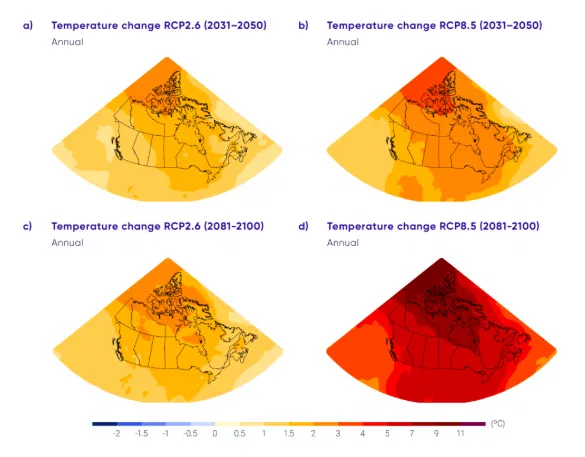
Maps of the projected annual mean temperature change (°C) with changes relative to the 1986 to 2005 period. Credit: Climate Research Division, Environment and Climate Change Canada
With the warming climate, heatwaves in both northern and southern regions are becoming more frequent, longer, and more severe. Just last month the town of Inuvik in North West Territories recorded a historic temperature anomaly – the afternoon temperature reached 8.7°C, which soared past the usual March average high of -16.8°C.
Warming across the seasons have not been uniform – winter has seen the largest increase in mean seasonal temperature by 3.3°C, 1.7°C in spring, 1.5 in summer, and 1.7°C in fall. Western and northwestern regions of Canada are seeing warming rates that are faster than the rest of the nation – winter warming has increased between 4°C to 6°C over the 1948 to 2016 period in B.C., Alberta, Yukon, Northwest Territories, and western Nunavut. The warming temperatures are set to influence fire weather, which are the weather conditions that determine fire danger. This is a particular concern for western Canada, as wildfire seasons have not only increased in length but have become more severe over time.
Across Canada, frost days have decreased by more than 15 and ice days by more than 10 between 1948 to 2016, and the number of hot days has increased. Hot days are defined as days with a maximum temperature above 30°C, and in southern regions of Canada, there could be an addition 50 hot days by the late century under the business-as-usual scenario, with approximately 40 fewer frost and ice days by 2100.
The decrease in frost and ice days has resulted in a longer growing season throughout the Prairies and southern regions of Ontario and Quebec. The growing season starts when there are six consecutive days with a daily mean temperature above 5°C in spring or summer and ends when this condition is not met. Between 1948 to 2016 the growing season increased by about a length of 15 days, which has significantly changed many farming practices and businesses.
PRECIPITATION: FLOODING RAINSTORMS, CHANGING RAINFALL PATTERNS
The report states that, in the future, extreme precipitation is projected to increase in Canada. An extreme precipitation event with a 1 in 20 year probability of occurring is projected to become, approximately, a 1 in every 10 year event by mid-century and a 1 in every 5 year event by 2100 (under a business-as-usual emission scenario).
Within these events the magnitude of the precipitation will change, meaning that more rain or snow will fall in each storm. The projections show that the amount of 24-hour extreme precipitation that occurs once in 20 years on average will increase by about 25 per cent by the end of this century in a business-as-usual scenario, with a 12 per cent increase by 2031 to 2050.
In the business-as-usual emission scenario, there will be 30 per cent more annual mean rainfall in the Canadian Arctic, which will exacerbate the melt of snow and ice. The drastic changes of Arctic precipitation patterns will significantly change the local environment and weather patterns as this area is used to very little annual precipitation. In contrast, some areas of Canada will see less rainfall each year.
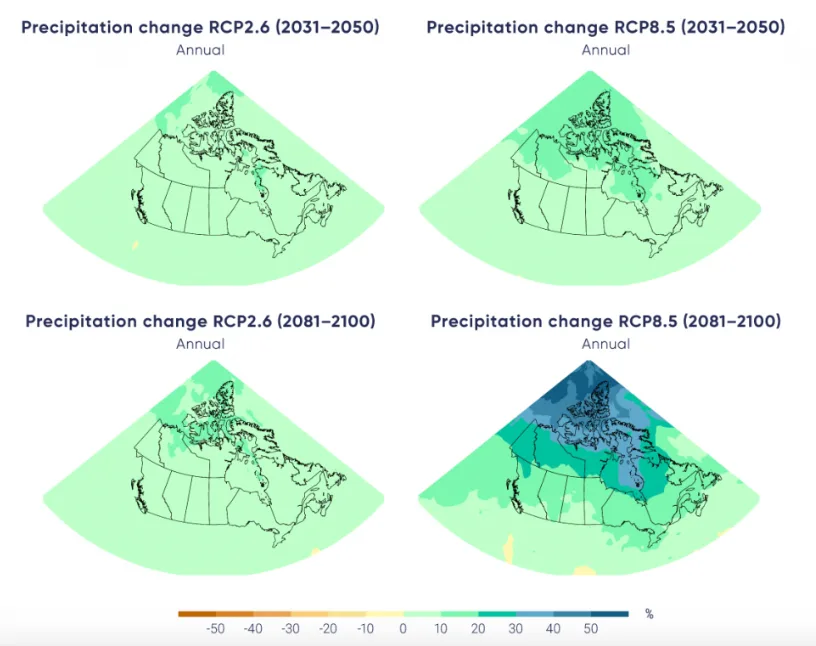
Maps of the projected annual mean precipitation change relative to the 1986 to 2005 period. From Chapter 4 figure 4.19. Credit: Climate Research Division, Environment and Climate Change Canada
Projections show that southwestern B.C. will see a median reduction of more than 30 per cent of precipitation in the summer, caused by overall surface drying and changes in atmospheric circulation patterns. This area already struggles with droughts and dry spells, which significantly increase the risk of wildfires and poor air quality.
Normalized precipitation, which is the amount of precipitation in an area divided by the long-term mean, has increased by about 20 per cent from 1948 to 2012 in Canada. The percentage increase was larger in northern Canada than in southern Canada.
The type of precipitation falling throughout Canada has also changed in recent decades. In both northern and southern regions, warming has steadily and significantly decreased the amount of precipitation falling as snow, especially during the spring and fall seasons, which has occurred almost entirely because the snow has been replaced by rain. The consequences of this change in precipitation greatly impact flood risks, river flow, and the timing of the spring freshet becoming significantly earlier.
WHAT EXTREME WEATHER EVENTS HAVE BEEN CONNECTED TO CLIMATE CHANGE?
Climate change research has increased investigation into “event attribution,” which is an emerging field that explores the connection between the warming climate and extreme weather conditions such as wildfires, droughts, and flooding. This new branch of climate science does not necessarily strive to answer the question 'Did human-induced climate change cause this specific extreme weather event to happen?', but looks to quantify that extent to which humans influenced the probability and strength of that weather event.
The graph below demonstrates a hypothetical illustration of how event attribution is calculated - climate variables without human influence are calculated and then compared with the current climate variables that are influenced by human activity. The shaded areas indicate the probability of an extreme event occurring in each scenario.
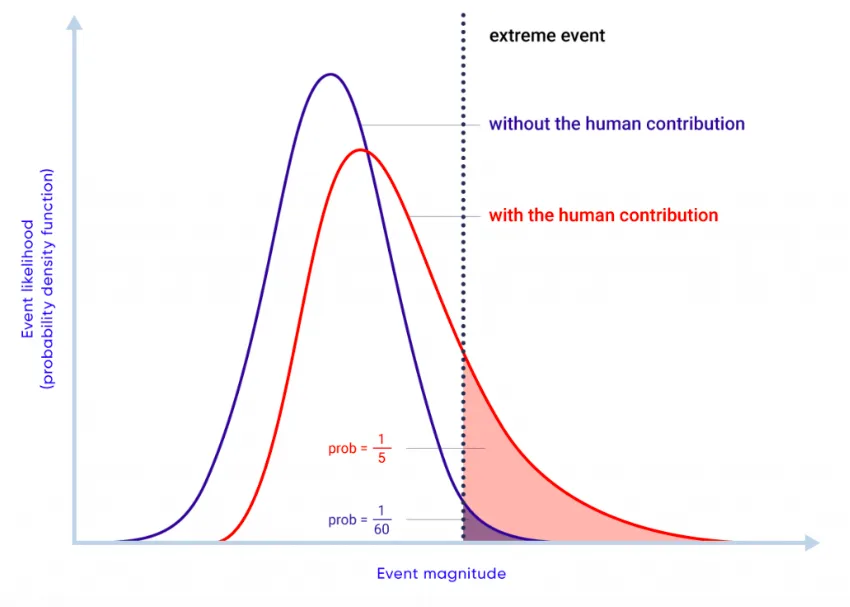
From Chapter 4 Figure 4.21. Credit: Environment and Climate Change Canada. Produced for CCCR by the Pacific Climate Impacts Consortium (PCIC)
The report notes that the increase in Canadian population and infrastructure contribute to the increase in costly extreme weather events, and state that changes in the intensity and frequency of these weather events may also have a role in these changes.
See below for how human-induced climate change influenced some of the most severe weather events in Canada's history:
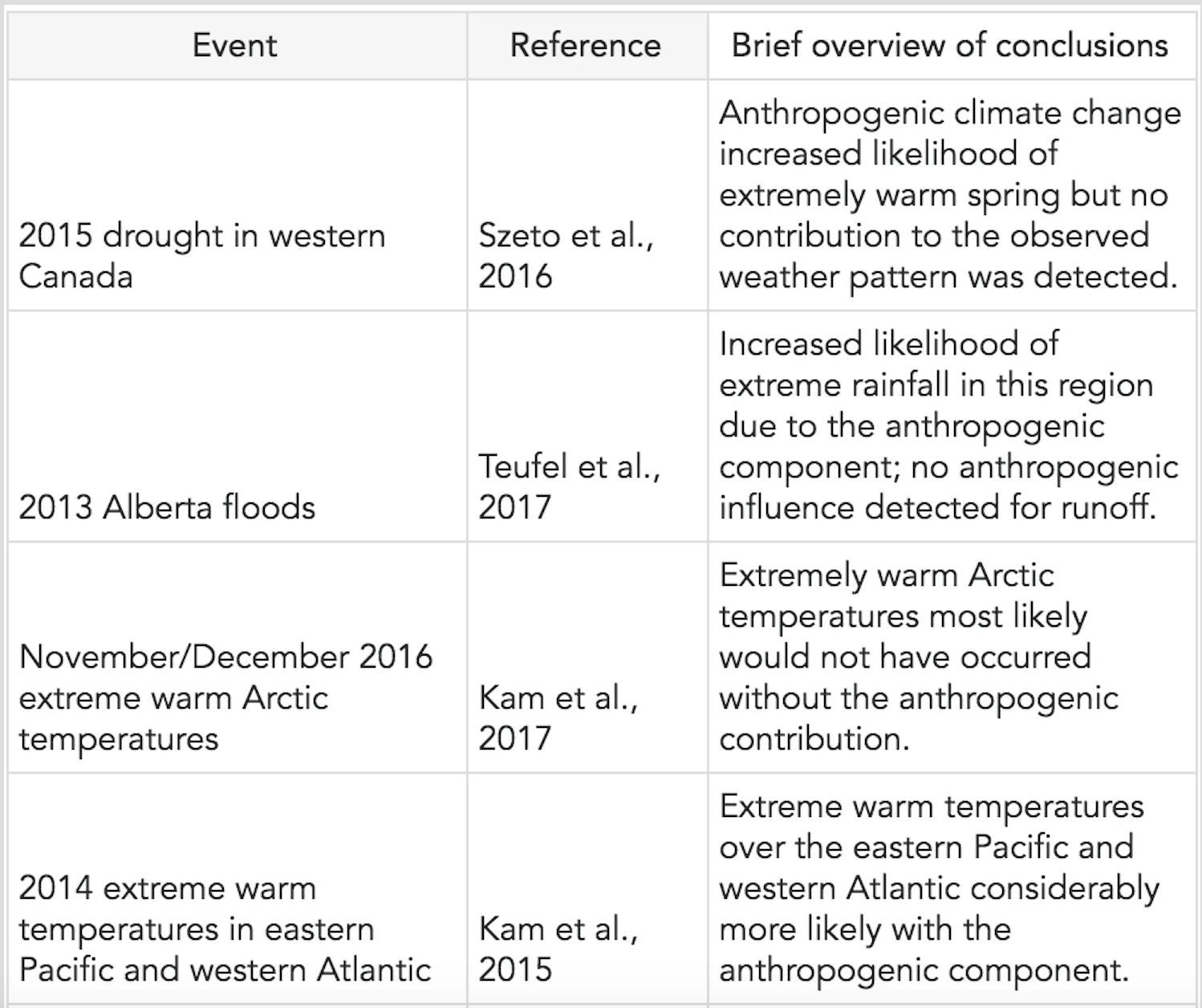
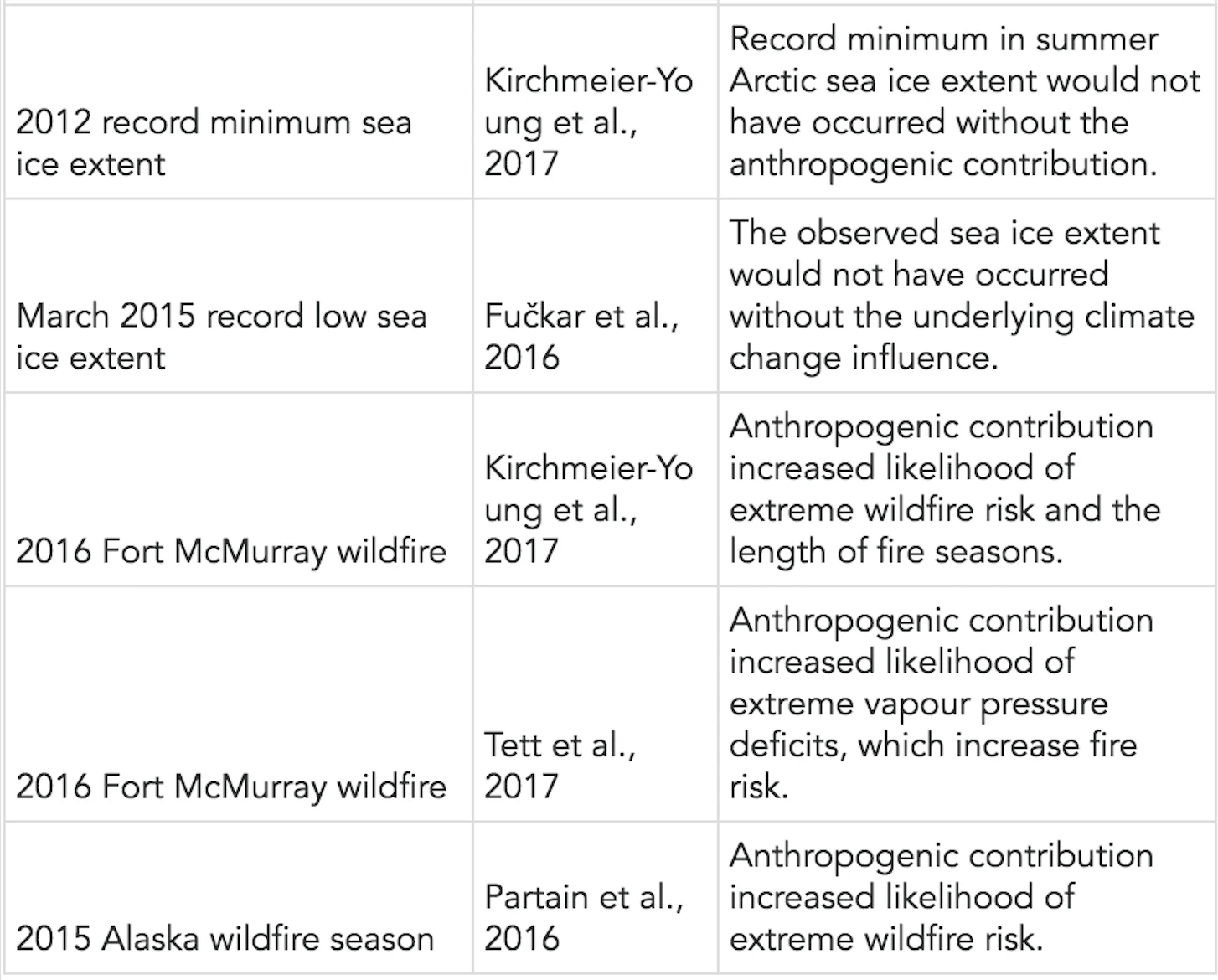
The main takeaways from this section of the CCCR report are that Canada's temperature and weather patterns are changing, and we have already seen the damaging potential of more severe weather events.
Future climate conditions are modelled using a variety of carbon emission scenarios, and the impacts from these different scenarios significantly vary. The low emission scenario minimizes the damages to infrastructure and property, as well as risks to human health. The Intergovernmental Panel on Climate Change recommends individuals take action to work towards a zero-carbon economy, as well as doing personal changes such as using public transit, energy-wise technologies, and future carbon-capture technologies to reduce our greenhouse gas emissions.










